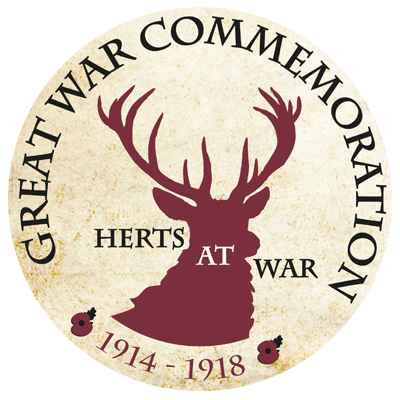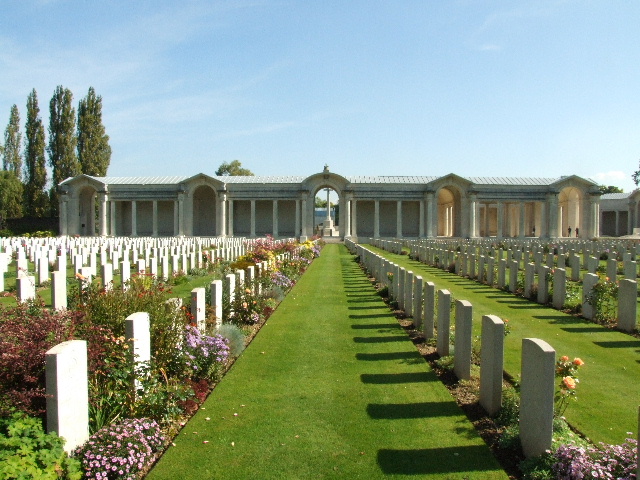Name
Ronald Lee Pyman
19 September 1886
Conflict
First World War
Date of Death / Age
03/05/1917
30
Rank, Service Number & Service Details
Lieutenant
Duke of Cambridge’s Own (Middlesex Regiment)
15th Bn., attached 12th Bn.
Awards: Service Medals/Honour Awards
1914 /15 Star, British War and Victory medals
Cemetery/Memorial: Name/Reference/Country
ARRAS MEMORIAL
Bay 7.
France
Headstone Inscription
NA
UK & Other Memorials
Hitchin Town Memorial, St Mary's Church Roll of Honour (Book), Hitchin, Jesus College Cambridge Memorial, Cambridge, Cambridgeshire, St Anselms Church Memorial, Hatch End, Greater London, Hatch End Book Of Remembrance, Hatch End, Greater London, Pinner Memorial, Pinner Greater London
Pre War
Wartime Service
Ronald went to France, arriving on 2 December 1914. He became a 2nd Lieutenant ‘On Probation’ to the 5th Duke Of Cambridge's Own (Middlesex Regiment) on 25 August 1914. He was Gazetted as such on 8 January 1915.
Catherine meanwhile joined the Voluntary Aid Detachment as a nurse and was sent to France.
We also have the following medical records for him, so he was definitely in France in July 1915.
The Admission and Discharge book for the Queen Alexandra Military Stationary Hospital at Millbank, London SW, records him as 28 years old and suffering Neurasthenia (a name for shell shock). He was admitted on 27 July 1915 but was discharged the following day to 10 Palace Green Kensington, London, W8 4QA. This was a special hospital for officers suffering from shell shock, which was created and run by Lord Knutsford.
There is a second record in another Admission and Discharge book for the Queen Alexandra Military Stationary Hospital. This records Ronald as 21 years old (incorrect) and suffering Exhaustion (Shock). It records that he was admitted on 30 July 1915 and his discharge on 19 August 1915 to 10 Palace green is recorded in one of the columns (headed ‘Observations’). Obviously, there are some discrepancies – probably in the second entry. Both records also suggest that Roland was with the 1st Battalion, but this also seems to be incorrect.
At the time of his death he was in the 15th Battalion of the Middlesex Regiment but attached to the 12th Battalion. The 12th Battalion was in the 54th Brigade of the 18th Division of the VII Corps of the Third Army and fought in what came to be known as the Battle of the Scarpe.
On the day he was killed in action there was a British attack on Cherisy village, and it was a prime example of an attack launched without proper preparation and irrespective of the number of lives it would cost. The initial problem was that although Officers and NCOs did know the plan of the operations, zero hour was put back to 3.45am and the attack began in the pitch dark, which was disastrous. The assaulting Battalions had no idea as to the lie of the land over which they were to attack, the enemy wire had not been cut and many died on that wire from machine-gun fire. Contact was lost with the flanks and by 10.15pm the survivors were back at their starting points. In the words of one 18th Division survivor "It was one bloody great balls-up". Fourteen officers and three hundred and four men were killed, wounded or missing in the debacle of that day. Ronald was reported missing in May 1917, and the family made at least one enquiry of the British Red Cross & Order of St John on 20 July 1917. This presumably provided no information, and later the Cheltenham Chronicle and Gloucestershire Graphic newspaper of 29 December 1917 reported that although previously reported missing he was now presumed killed.
Ronald has no known grave but is remembered on the Arras Memorial to the Missing in France.
In the 1918-19 Jesus College Cambridge Society Annual Report obituary for Pyman he is described as being “perhaps the wittiest man of his time”. It also says that he was “an excellent platform speaker and hoped ultimately to enter upon a parliamentary career.” His stage presence perhaps came from appearing in the 1906 Footlights production “A Classical Trip”. (Footlights! A Hundred Years of Cambridge Comedy by Robert Hewison, p195).
When he left College he joined the Imperial Oil Company as an Assistant Manager in Melbourne, Australia. According to the obituary he was in England at the outbreak of war and joined up immediately via the Inns of Court OTC. He spent some time in France and was at one point invalided home. He returned to the Front in April 1917. He was killed in action in May 1917
His obituary ends “He leaves a widow and a son” (pp28-29).
Additional Information
After Ronald’s death a gratuity of £140 was paid to Catherine Freyda Lucie (Lucil in one record) Pyman of Bradley Court, Wotton-under-Edge, Gloucestershire. Then a widow’s pension of £100 per year paid quarterly.
Then there is another entry naming their child Lawrence Lee Pyman, it lists an allowance of £24 per year, commencing 4 May 1917 to end on 13 March 1935. Another £6 0s 9d was issued to his mother for the period 4 May to 3 August 1917. There is also a note “Issued from 4 Aug 1917 to 31 May 1918 Pay at Pension rates”, and £4 16s, a ‘‘bonus 1919-1920’ was authorised to go to her his widow later.
Probate was obtained by his widow and Frank Lee Pyman (Doctor of Science) on 5 March 1918, with the value of his effects £2232 13s 3d.
His widow, Catherine, married again, marrying Captain R G Roberts MC – the marriage war reported on 22 June 1920 in The Times. They set up home firstly in Nottingham, then at Ash near Aldershot and finally Deddington, Buckinghamshire.
Two brothers also served, Major Colin Keith Lee Pyman (DSO and Bar) who was killed on 10 August 1918 and Geoffrey Lee Pyman also served and was in Italy from 27 August 1915 rose to Lieutenant Colonel DSO., MC and survived.
*1 Lawrence never saw his father. He became extremely interested in flying and joined the University Air Squadron. He became a commissioned officer in the RAF Volunteer Reserve in January 1939 and was called up at the outbreak of war in September 1939. He completed his training at RAF Cranwell and was then posted to 6 OTU Sutton Bridge where he flew Spitfire. He was killed on 26 August 19140. There is an excellent biography for him that can be viewed via one of the links below.
The HAW research has been combined with two other sources of information which we recommend visiting, they are https://www.jesus.cam.ac.uk/ronald-lee-pyman-lieutenant-middlesex-regiment and https://www.bbm.org.uk/airmen/Pyman.htm. We thank Dr Rob Payne (College Archivist) and Edward McManus (Battle of Britain London Monument) respectively for their help and permission to include the information.
Acknowledgments
David C Baines, Jonty Wild, Dr Rob Payne (College Archivist) and Edward McManus (Battle of Britain London Monument)



